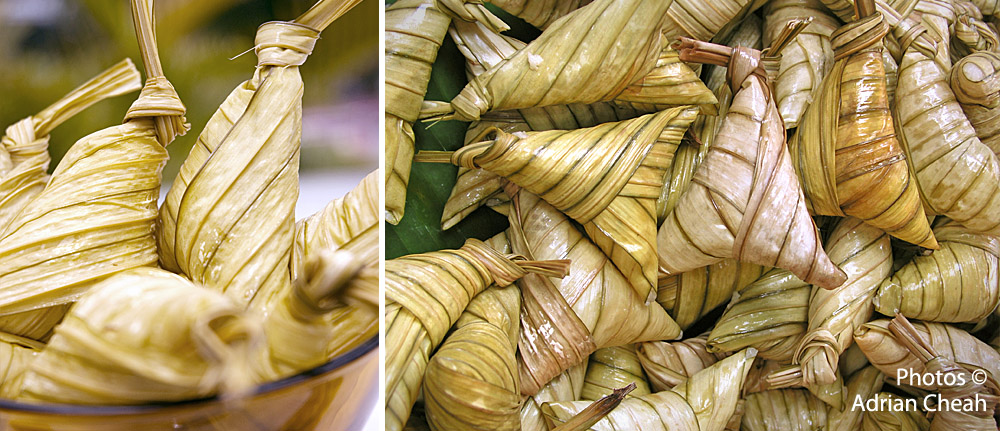Make your own ketupat daun palas (glutinous rice wrapped in palm leaves)

The most popular types of ketupat found in Malaysia are ketupat nasi (made with plain rice) and ketupat daun palas (made with glutinous rice). While both varieties are wrapped in palm leaves and then boiled, they use different types of leaves: ketupat nasi is typically wrapped in young coconut leaves (daun kelapa muda), whereas ketupat daun palas is enclosed in Licuala palm leaves (daun palas). It is said that ketupat daun palas originated from the northern states – Penang, Kedah and Perlis – while ketupat nasi is more popular in Perak.
A taste of tradition

When I was growing up in Ipoh, ketupat nasi was served on the morning of the first day of Syawal just before the Raya prayers. Ketupat and rendang are usually the main dishes of any Hari Raya spread.

Ketupat daun palas, on the other hand, is a delicacy commonly found in the northern region of Malaysia and shares similarities with dishes from southern Thailand, where local variations exist. Traditionally, it was a staple food for travellers and traders because of its long shelf life.

A recipe to try
Ingredients
- 2.5 kg glutinous rice (soaked overnight)
- 3 kg coconut milk (add in 2 tsp salt)
- 500 g black-eyed beans (soaked and pre-cooked until soft) – optional
- Palas (Licuala palm leaves)
Method
- Wash the uncooked glutinous rice with running water until it is clean and soak overnight. When ready, drain the glutinous rice and set aside.
- Heat on medium flame, simmers the coconut milk with a little salt in a large pot.
- Add the glutinous rice, stirring continuously for about 20 minutes until the rice is half cooked. For extra bite and flavour, add boiled black-eyed beans to the mixture and stir. Set aside and leave to cool.
- Take a small portion of the semi-cooked glutinous rice and place it in the centre of a palm fronds. Weave the frond into a triangular shape and secure the parcel with a knot on the top (search YouTube for tutorials).
- Immerse the wrapped rice into a vat of boiling water, cooked it about 1-2 hours on low heat). Cooked glutinous rice is usually quite soft when pressed.
- Drain and let it cool down for several hours before serving.
Variations and serving suggestions

For a delightful twist, consider mixing black and white glutinous rice to achieve a rich burgundy hue. The addition of white glutinous rice softens the texture, while some prefer to include red beans for added depth of flavour.

Ketupat daun palas is best enjoyed at room temperature, often paired with dried curry (rendang), spiced beef floss (serunding daging), or other aromatic, spicy condiments. However, its subtly sweet and creamy flavour also makes it delicious on its own or with a sprinkle of sugar.

Trivia and fun facts
- Nature’s perfect wrapper: The Licuala palm leaves not only serve as an eco-friendly, biodegradable wrapper but also infuse the ketupat with a delicate, earthy aroma.
- Ketupat vs. Lemang: While ketupat daun palas and lemang both feature glutinous rice and coconut milk, lemang is traditionally cooked in bamboo over an open fire, imparting a distinct smoky fragrance.
- Tips for beginners: Make sure the leaves are flexible by lightly steaming them or soaking them in warm water before use.

Ketupat daun palas is available at the month-long Ramadhan bazaar throughout Penang, as well as in frozen form at supermarkets or online.
-------------------------------------
Written by Raja Abdul Razak
Photographed by Adrian Cheah © All rights reserved
17 August 2017